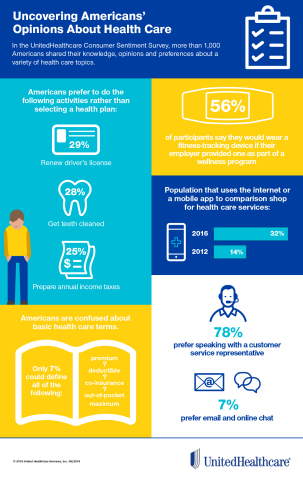MINNETONKA, Minn.--(BUSINESS WIRE)--More Americans are using technology to improve access to health care and make more informed decisions, even as most have a limited understanding of basic health insurance terms or the cost of specific medical services, according to a new study from UnitedHealthcare.
These are some of the findings from the UnitedHealthcare Consumer Sentiment Survey, which examines Americans’ attitudes and opinions about four areas of health care: comparison shopping, wellness programs, health literacy and customer service.
The survey’s key findings include:
- People prefer other activities to enrolling in a health benefits plan during open enrollment. For example, a quarter (25 percent) of respondents said they would rather file their annual income taxes than select a health plan.
- More Americans are now comparison shopping for health care. Nearly a third of respondents have used the internet or mobile apps during the last year to compare the cost of medical services. That is more than double from 14 percent in 2012 (based on a previous UnitedHealthcare survey).
- Most people don’t fully understand what they are buying. Only 7 percent of respondents could successfully define all four basic health insurance concepts: plan premium, deductible, co-insurance and out-of-pocket maximum.
- When it comes to customer service, Americans prefer live support. More than three-quarters (78 percent) of respondents preferred speaking with a customer service representative, with email or online chat the next most popular options at 7 percent each.
“This survey underscores why UnitedHealthcare is working to simplify the health care experience for people and help them take full advantage of their health care benefits,” said Rebecca Madsen, UnitedHealthcare chief consumer officer.
Comparison Shopping Becomes More Popular
The use of
websites and mobile apps to comparison shop for health care is
increasing, especially among young people. Nearly half (47 percent) of
respondents between the ages of 18 and 34 said they have used online or
mobile resources to comparison shop for health care treatments or
services. Among all comparison shoppers, 81 percent described the
process as “very helpful” or “somewhat helpful.”
More broadly, many people do not know what specific medical services cost. For instance, the average nationwide cost for a knee replacement is $35,000, according to the health care price transparency website www.guroo.com. Eleven percent of respondents selected $35,000 correctly as the average cost for this procedure; a majority of respondents (63 percent) estimated the cost of knee replacement to be much lower: $5,000 (14 percent), $15,000 (28 percent) and $25,000 (21 percent).
Health Literacy Remains a Challenge
In spite of the
survey’s data about U.S. consumers’ increased willingness to use
technology to help improve health care knowledge and access, many
Americans do not understand basic health insurance concepts that are
important to using their health plan benefits.
Only 7 percent of respondents could successfully define all four basic health insurance concepts: plan premium, deductible, co-insurance and out-of-pocket maximum. More than 60 percent of respondents successfully defined plan premium and deductible; however, respondents had a more difficult time defining out-of-pocket maximum (36 percent) and co-insurance (32 percent).
Even in the internet age, the survey found nothing beats speaking with a real person to address a specific question or issue. Nearly 80 percent of respondents preferred speaking directly with a customer service representative, with email or online chat the next most popular at 7 percent each.
The most important quality when calling a customer service representative was the person’s knowledge (30 percent), followed by how quickly the call was answered (27 percent), and then feeling the representative had all the necessary information on hand (22 percent).
Consumers Show Interest in Wearables, Telemedicine
Many
survey respondents expressed interest in other health-related
technologies.
More than half of respondents (56 percent) who are employed full time said they would be interested in using a wearable fitness tracker as part of a workplace wellness program. That’s good news considering companies nationwide are expected by 2018 to incorporate more than 13 million fitness tracking devices into their wellness programs as a way to help reduce obesity and sedentary time among employees, according to technology consultancy Endeavors Partners.
In regard to telemedicine, 37 percent of respondents said they were “very likely” or “somewhat likely” to use a smartphone, tablet or computer to access health care services.
For complete survey results, visit the UnitedHealthcare newsroom at www.uhc.com.
About the Survey
The UnitedHealthcare Consumer Sentiment
Survey was conducted using ORC International’s Telephone CARAVAN omnibus
among a landline and cell phone probability sample of 1,011 U.S. adults
age 18 and older. Some supplemental interviewing was conducted among a
second sample of 1,009 adults. The margin of error for each sample was
plus or minus 3.1 percent at the 95 percent confidence level.
About UnitedHealthcare
UnitedHealthcare
is dedicated to helping people nationwide live healthier lives by
simplifying the health care experience, meeting consumer health and
wellness needs, and sustaining trusted relationships with care
providers. The company offers the full spectrum of health benefit
programs for individuals, employers, military service members, retirees
and their families, and Medicare and Medicaid beneficiaries, and
contracts directly with 1 million physicians and care professionals, and
6,000 hospitals and other care facilities nationwide. UnitedHealthcare
is one of the businesses of UnitedHealth Group (NYSE: UNH), a
diversified Fortune 50 health and well-being company. For more
information, visit UnitedHealthcare at www.uhc.com
or follow @myUHC on Twitter.
Click here to subscribe to Mobile Alerts for UnitedHealth Group.




